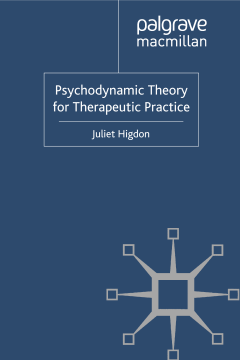
Additional Information
Book Details
Abstract
The work of Freud and the pioneers who followed in his footsteps offers a rich and diverse source of ideas for those working, or training to work, in the helping professions. However too often this body of theory comes across as abstract and can be difficult to grasp. This refreshingly clear book provides a brilliantly readable account of the major psychodynamic theories, unpacking complex theory and showing the people behind the ideas.
Originally published as From Counselling Skills to Counsellor and significantly refreshed and revised in its second edition, this text guides readers through how key concepts first originated, how they developed and how they apply in practice today. This updated edition:
- Discusses the contributions of five key figures in the field: Freud, Klein, Winnicott, Bion and Bowlby
- Presents compelling case studies throughout which powerfully illustrate psychodynamic theory in practice
- Explores the legacy of psychodynamic theorists in two new chapters, including feminism and developments in attachment theory
- Shows how psychodynamic theory can help practitioners in building and understanding the therapeutic relationship
An insightful introduction to core psychodynamic theory, this text is invaluable reading for all students, trainees and practitioners in counselling and psychotherapy, and of interest to those studying and working in the fields of nursing, social work and counselling psychology.
JULIET HIGDON is a BACP Senior Accredited counsellor/psychotherapist working in independent practice with individuals, couples and organisations. She trained at the Tavistock Clinic in a psychodynamic approach to clinical practice and has many years experience in counsellor training, including heading the counselling training at South Tyneside College for fifteen years.
Table of Contents
| Section Title | Page | Action | Price |
|---|---|---|---|
| Cover | Cove | ||
| Contents | vii | ||
| List of case material examples | x | ||
| Preface | xii | ||
| Acknowledgements | xiii | ||
| Introduction | 1 | ||
| The psychodynamic approach | 1 | ||
| Psychoanalytic history | 4 | ||
| Diversity | 6 | ||
| Structure of the book | 10 | ||
| 1 The value of psychodynamic theory | 13 | ||
| The value of psychodynamic theory | 13 | ||
| Using psychodynamic theories in counselling | 14 | ||
| The past informs the present | 17 | ||
| The talking cures | 23 | ||
| Motivation for being a counsellor | 27 | ||
| Further reading | 30 | ||
| 2 Freud: where it all started | 31 | ||
| Influence of Freudian ideas | 32 | ||
| Life of Sigmund Freud | 33 | ||
| The topographical approach to mental processes | 39 | ||
| So what can counsellors learn from this quite complex theory? | 41 | ||
| Defence mechanisms | 50 | ||
| Psychosexual stages of development | 53 | ||
| The Oedipus complex | 54 | ||
| The basic rule | 64 | ||
| Comment | 66 | ||
| Further reading | 72 | ||
| 3 Klein: mothers and babies | 73 | ||
| Life of Melanie Klein | 74 | ||
| The mother and baby relationship | 80 | ||
| Managing the paranoid schizoid position | 88 | ||
| Kleinian application | 104 | ||
| Comment | 104 | ||
| Further reading | 108 | ||
| 4 Winnicott: holding within boundaries | 110 | ||
| Life of Donald Winnicott | 110 | ||
| The mother–baby relationship | 116 | ||
| A place to play | 125 | ||
| The creative potential and the self | 128 | ||
| Cross identification | 129 | ||
| Hate in the countertransference | 132 | ||
| Comment | 134 | ||
| Further reading | 137 | ||
| 5 Bion: knowing and not knowing | 138 | ||
| Life of Wilfred Bion | 138 | ||
| Thinking and containment | 143 | ||
| Knowing and not knowing | 149 | ||
| Curiosity | 152 | ||
| Competence | 152 | ||
| Comment | 155 | ||
| Further reading | 157 | ||
| 6 Bowlby: attachment and separation | 158 | ||
| Life of John Bowlby | 160 | ||
| Maternal deprivation | 163 | ||
| Attachment | 164 | ||
| Separation | 169 | ||
| Loss | 178 | ||
| Comment | 185 | ||
| Further reading | 186 | ||
| 7 Legacies I: from Freud to feminism | 187 | ||
| The legacy of Freud: neo-Freudians | 188 | ||
| Developments of the Oedipus complex | 195 | ||
| Feminism and psychoanalysis | 203 | ||
| The legacy of Klein on child development theory and practice | 206 | ||
| Comment | 211 | ||
| Further reading | 212 | ||
| 8 Legacies II: developments in attachment theory | 213 | ||
| The legacy of Winnicott | 213 | ||
| The legacy of Bion: the psychodynamic theory of organizations | 218 | ||
| The legacy of Bowlby: attachment theory and research | 222 | ||
| Comment | 230 | ||
| Further reading | 232 | ||
| 9 Practice | 233 | ||
| Links | 233 | ||
| Building the therapeutic relationship | 240 | ||
| Using the relationship | 243 | ||
| Understanding the relationship | 250 | ||
| Brief therapy | 256 | ||
| Endings | 263 | ||
| Further reading | 264 | ||
| Bibliography | 266 | ||
| Index | 275 |
